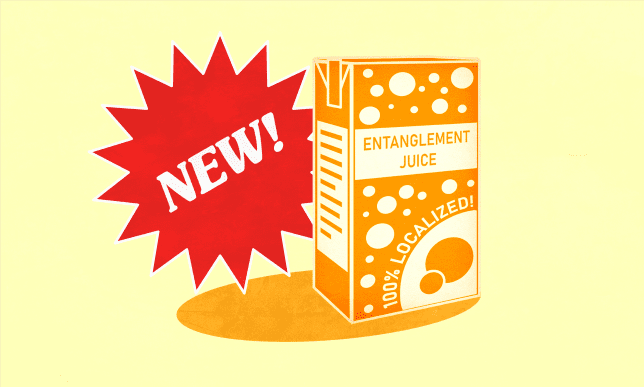Distillation method strengthens quantum entanglement in a single pair of photons
04 Oct 2021 Chunyang Ding
Quantum entanglement is a valuable resource, enabling spy-proof communications and allowing quantum algorithms to be faster than classical ones. But like other quantum phenomena, entanglement is also extremely delicate and sensitive to environmental noise. Because many quantum communication protocols require high levels of entanglement to operate properly, preserving that entanglement is crucial.
There is a solution, but it comes at a hefty price. By sacrificing some poorly entangled quantum objects, physicists can create a better-entangled pair out of the objects that remain – a little like reducing a weak broth into a hearty soup by boiling off the excess water. This method of increasing entanglement in quantum objects is known as entanglement distillation and was first described theoretically in the late 1990s. Since then, it has been demonstrated in all kinds of quantum systems, from superconducting circuits to photons. Now, however, researchers at the Institute of Quantum Optics and Quantum Information (IQOQI) at Vienna have demonstrated entanglement distillation using only a single pair of photons. By using the various quantum properties embedded in this photon pair, these researchers can generate and distribute entanglement more quickly, more easily and with greater protection than ever before.
Boil down your qubits
Entanglement allows pairs of quantum objects to communicate with each other, regardless of how separated they are in space. This property makes entangled pairs of photons extremely useful, as it can allow two parties to whisper secrets to one another, knowing that no one else can eavesdrop without disturbing their delicate quantum system. However, entanglement can be degraded by the environment over time, making it harder and harder for the entangled photons to “hear” each other clearly. Drop by drop Entanglement distillation is akin to reducing a dilute solution into a concentrated one, only instead of using heat and time, the procedures rely on complex quantum circuitry. (Courtesy: Sebastian Ecker)
Drop by drop Entanglement distillation is akin to reducing a dilute solution into a concentrated one, only instead of using heat and time, the procedures rely on complex quantum circuitry. (Courtesy: Sebastian Ecker)
 Drop by drop Entanglement distillation is akin to reducing a dilute solution into a concentrated one, only instead of using heat and time, the procedures rely on complex quantum circuitry. (Courtesy: Sebastian Ecker)
Drop by drop Entanglement distillation is akin to reducing a dilute solution into a concentrated one, only instead of using heat and time, the procedures rely on complex quantum circuitry. (Courtesy: Sebastian Ecker)Entanglement distillation reverses this noise, reviving the entanglement and giving the pair of photons a new life via a protocol involving quantum logic operations known as controlled-not (CNOT) gates. Traditionally, this protocol is pretty wasteful: each distillation step sacrifices a good pair of photons, and even worse, there is no fail-proof way to guarantee the operation will succeed. The IQOQI researchers, however, found a better way. “You can perform these controlled-not gates not just between two photons, but between two properties of the same photons,” explains Sebastian Ecker, a PhD student at the IQOQI and first author of a report published in Physical Review Letters.
Leveraging degrees of freedom
Photons have many uniquely quantum properties, such as their polarization state, energy level, and spatial mode. Collectively, physicists refer to these properties as “degrees of freedom” and all of them have been used independently to demonstrate entanglement. However, the IQOQI study is the first experiment to demonstrate entanglement distillation with different degrees of freedom.
In their experiment, the researchers generate entangled photons pairs using a nonlinear crystal, then send each photon in the pair to a different optical table. Each table holds a labyrinth of optical devices that perform the entanglement distillation step and interpret the results. At the core of this labyrinth is an unassuming optical device called a polarizing beamsplitter. This small glass cube transforms the state of the photons, changing the quantum state of the photon’s polarization only if certain conditions are met with the photon’s energy-time domain. That action exactly describes a CNOT logic gate, one of the basic logical building blocks of quantum computing. After this distillation process is complete, the researchers measure the properties of the photon pair and determine how much entanglement was recovered.READ MORE

The researchers also verified that their distillation process is robust by intentionally inserting noise into the environment. Because that noise is very carefully controlled, they can quantify how well their new procedure works in noisy environments, showing that their method for entanglement distillation is faster than traditional two-pair methods by a factor of 100 million. “In our experience, these degrees of freedom are robust enough to revive entanglement after passing through long optical fibres or free-space links,” Ecker says.
A perfectly entangled world
Because polarization and energy-time are both frequently used in other aspects of quantum communication, the researchers are confident that their scheme will soon find many other applications. After considering how this method might improve on previously extracted quantum keys. their sights are now set even higher. “Wouldn’t it be nice if you could use the high dimensional entanglement to make your qubit entanglement noiseless? This would be really cool,” Ecker says.

Chunyang Ding is a PhD student contributor to Physics World. Chunyang is studying quantum computing at the University of Chicago. Find out more about our student contributor networks
from physicsworld.com 4/10/2021

Δεν υπάρχουν σχόλια:
Δημοσίευση σχολίου